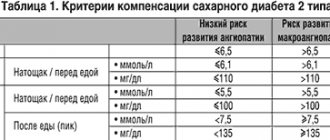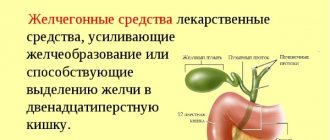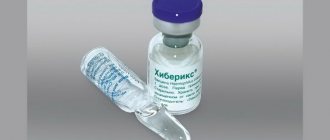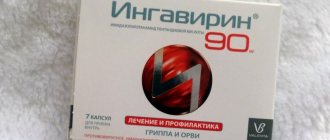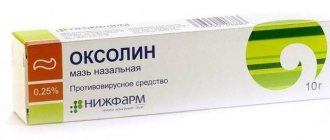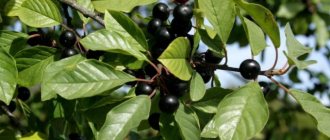Release form and composition
Arfazetin-E is available in the following dosage forms:
- plant powder collection: a grayish-green mixture of heterogeneous fragments of plant materials interspersed with white, cream, light yellow, yellowish-gray, grayish-brown, brownish-red and orange-red colors; raw material particles pass through a sieve with 5 mm holes; the powder collection has a faint aromatic odor; the aqueous extract has a bitter-sour taste (2 g each in filter bags, in a cardboard pack there are 10, 20, 24, 30 or 50 filter bags; 2.5 g each in filter bags, in a cardboard pack there are 20 filter bags) ;
- crushed vegetable raw materials: a yellowish-green mixture of various types of raw materials with dark green, cream, brown, brownish-red, grayish-brown and yellowish-white inclusions, particles of which pass through a sieve with 5 mm holes; the collection has a faint aromatic odor; the aqueous extract has a bitter-sour taste (30, 35, 40, 50, 60, 75 or 100 g in cardboard packs with an inner plastic, polypropylene or paper bag).
Each cardboard box contains instructions for use of Arfazetin-E.
Composition of the collection powder and crushed raw materials (in percentage):
- common bean fruit leaves – 20%;
- common blueberry shoots – 20%;
- rose hips – 15%;
- roots and rhizomes of Eleutherococcus senticosus – 15%;
- chamomile flowers – 10%;
- St. John's wort herb – 10%;
- horsetail grass – 10%.
Pharmacodynamics and pharmacokinetics
Pharmacodynamics
Arfazetine helps reduce blood glucose and stimulates the glycogen-forming function of the liver. In diabetes mellitus, carbohydrate tolerance is reduced because the amount of insulin decreases and blood glucose The drug increases tolerance to carbohydrates.
The action is determined by flavonoids, triterpene glycosides, anthocyanin glycoside, silicic acid, carotenoids and organic acids, saponins contained in the plant raw materials of the collection: blueberries, bean leaves, rose hips, horsetail and St. John's wort, chamomile flowers.
These substances have a hypoglycemic effect, therefore, in some cases, taking an infusion can reduce the daily dose of oral hypoglycemic agents for type II diabetes. In type 1 diabetes, no significant hypoglycemic effect is observed.
The bioflavonoid complex of the collection also has membrane-stabilizing and antioxidant effects.
Pharmacokinetics
No information available.
Arfazetin-E, instructions for use: method and dosage
The infusion, regardless of the method of preparation and the form of release of the drug used, is taken orally warm half an hour before meals, after shaking it.
Single dose – 1/3–1/2 cup. The drug is taken 2-3 times a day.
The duration of the course is from 20 to 30 days. After 10–15 days, it is recommended to repeat the course, and in total you can take 3–4 courses within a year (after consultation with your doctor).
Preparation of the infusion:
- collection powder: 2 filter bags (4–5 g of raw materials) are placed in an enamel or glass container and poured with one glass (200 ml) of boiling water, then cover with a lid and leave for 15 minutes. During infusion, the bags are periodically pressed with a spoon, after which they are squeezed out and the volume of the infusion is brought to 200 ml, adding boiled water;
- crushed raw materials: 1 tablespoon (about 5 g of raw materials) is placed in an enamel bowl and poured with one glass (200 ml) of boiling water, covered with a lid and heated in a water bath for 15 minutes. Then the infusion is gradually cooled for 45 minutes at room temperature, after which it is filtered and the remaining raw materials are squeezed out, the volume of the infusion is adjusted to 200 ml, adding boiled water.
Reviews about Arfazetine
Reviews about Arfazetine are positive. The effectiveness of the collection was proven by laboratory studies. The general health of the patients improved.
“The collection helped a lot. I took 3 tablets of Diabeton and started drinking Arfazetin 3 times a day. I was able to gradually reduce the number of tablets from three to one.”
“...I drink a bag of this mixture 3-4 times a day. Sugar is normal. Following a diet is mandatory + a little physical activity.”
“In the initial stages of diabetes, I recommend trying Arfazetine, it showed a good reduction in sugar for me.”
“My sugar reduction from this collection is more noticeable than from other collections.”
The most common side effects are increased blood pressure in people prone to hypertension and heartburn with a history of gastritis or gastroesophageal reflux disease .
Special instructions and contraindications
The herbal mixture, like all medicines, has contraindications and special instructions for its use:
- The effect of the drug has not yet been put on a scientific platform regarding its effect on pregnancy and lactation. In these cases, it is simply not prescribed unless absolutely necessary.
- Not recommended for children under 12 years of age.
- Prescribe with extreme caution to elderly people. They take into account that almost all older people may have kidney problems and high blood pressure.
- The medicine should not be taken at night. Possessing a tonic property, it can cause insomnia.
- People taking the collection should avoid direct sunlight.
Mechanism of action on the body
It is worth paying attention to the fact that such a herbal mixture acts more slowly than conventional medications, but has a milder effect on the human body.
The number of adverse reactions is several times less than that of classic tablets. The price of Arfazetine for the prevention of diabetes is also encouraging.
A package costs on average 50-70 rubles, depending on the pharmacy that sells the product, so it can be considered quite affordable as a preventive measure.
The main effects that this natural remedy has on the human body are the following:
- Hypoglycemic. The most important aspect for the prevention of the “sweet disease”. Blood sugar is reduced due to the presence of myrtilline in blueberries. It directly affects carbohydrate metabolism and increases tissue sensitivity to the effects of insulin.
- Arfazetine improves microcirculation. A high percentage of vitamin C and E normalizes blood circulation in the smallest arterioles and veins, which promotes the activation of all metabolic processes and additional utilization of glucose.
- Antibacterial. Alkaloids and flavonoids contained in the herb St. John's wort and horsetail have a pronounced antimicrobial effect. Thus, the body is less likely to be invaded by pathogenic microflora.
- Immunomodulatory. Vitamins and microelements from plants stimulate the body's own defense mechanisms. Patients who regularly use this herbal mixture note a decrease in the number of episodes of colds.
- Calming. A positive effect of chamomile extract on the human nervous system has been observed. Resistance to stressful situations and emotional shocks increases. Your mood improves.
As is clearly seen from the indicated properties of the drug, the prevention of diabetes mellitus and Arfazetin are very combinable concepts. You need to know that only the effectiveness of this remedy has been clinically proven in people with a predisposition to type 2 of the disease. If there is a risk of developing absolute insulin deficiency, then such a herbal mixture will not help.
Contraindications
The herbal mixture should not be used by patients who have individual hypersensitivity to individual components of the drug.
Carefully
Clinical cases in which the use of Arfazetin E is undesirable, but is allowed with extreme caution (when the therapeutic response from its use exceeds the risks of possible complications):
- insomnia;
- epilepsy;
- excessive emotional excitability;
- mental instability;
- peptic ulcer of the stomach and duodenum;
- arterial type hypertension.
The dosage and frequency of taking the herbal collection in these cases are calculated by the doctor individually.
Method of preparation of Arfazetine and use in diabetes mellitus
Arfazetin is highly effective in the treatment of type 2 diabetes mellitus. In mild cases of diabetes, the drug can be prescribed as an independent remedy, but subject to a special diet and recommended physical activity. For the treatment of moderate diabetes mellitus, it is recommended to use Arfazetin in combination with other medications intended to normalize the concentration of glucose in the blood.
"Arfazetin" is a collection of herbs that must be properly prepared before use. To do this, you will need to pour 2 tablespoons of raw materials with 2 cups of boiling water and place in a water bath. After 20 minutes, filter the finished broth, squeeze and add water to the original volume. Cool the finished medicine to room temperature and take it in the prescribed dosage. For the treatment of diabetes mellitus, adults are recommended to drink 100 ml three times a day 40 minutes before meals. Children under 15 years of age should take 20 ml of Arfazetin before breakfast, lunch and dinner. Depending on the child's age and general condition, the doctor may increase or decrease the dosage.
"Arfazetin", which is sold in sachets, is brewed as follows:
- Place 4 sachets in a liter container.
- Fill them with half a liter of boiling water.
- Leave to infuse for 35 minutes.
Adults are recommended to take a glass twice a day, and small patients - 2 tbsp. l. or ½ cup depending on age. The remaining infusion is stored in the refrigerator, but no more than 2 days. Shake the medicine well before use. The duration of therapy for diabetes mellitus with Arfazetine is one month. If it is necessary to extend the treatment, you need to take a 2-week break and repeat the treatment course.
Overdose and side effects
The herbs included in the collection can cause allergies, so start drinking with great caution.
Side effects are identified:
- hypertension, urinary dysfunction
- insomnia, irritability
- gastric secretion disorder
The drug should not be taken lightly. Many people think: if it’s grass, you can drink it however you want and as much as you want. Such a misconception is dangerous with serious consequences.
The ingredients in the collection have a wide range of active effects on the body. Its reception requires serious consideration. The first signs of an overdose cannot be ignored. These may be: bitterness in the mouth, heaviness in the liver area.
At the first, even the slightest, signs of an overdose, you should immediately stop taking it and seek help from a medical facility.
Drug interactions and shelf life
There are quite a lot of recommendations for the simultaneous use of the collection with other medications.
Concomitant use is contraindicated:
- antibiotics sulfonamides;
- contraceptives, anticoagulant hormones, calcium channel blockers;
- statins, many heart medications;
- antidepressants, theophylline.
There was a decrease in the absorption of iron-containing drugs and a weakening of the effect of anesthesia during abdominal operations.
In any cases of parallel use of the drug with other drugs, a doctor’s recommendation is necessary.
Shelf life is two years from the date of production. The drug is stored in a dry place, protected from sunlight. Ready infusion at a temperature not exceeding 15 degrees for one day. After the expiration date, the collection is not suitable for consumption.
Indications for use
The effect of the medicine is most effective in the initial stages of the disease. When used in parallel with medications, the amount and dose of the latter are gradually reduced.
For patients who can no longer cope without Insulin injections, taking Arfazetine will be ineffective.
It is especially popular for preventive purposes. Along with physical activity and a balanced diet, it is prescribed for the prevention and restoration of proper carbohydrate metabolism.
Doctors recommend collecting it for mild to moderate diseases, as well as for the prevention of diabetes.
Positive effects of Arfazetine
Despite the low effectiveness of traditional treatment (in our case, treatment with a decoction), Arfazetin has established itself as an effective remedy against a common disease - diabetes. The positive results of herbs have been proven by many medical specialists who have conducted thorough research. Among 100 subjects, 83 people noted an improvement in their well-being after several doses of this collection.
As your own evidence, it is enough to take a decoction of Arfazetine daily, and after 2 weeks, measure the results daily with a glucometer, which will not keep you waiting. Initially, you need to measure your sugar level before taking Arfazetine, then the next control measurements can be taken after 14 days.
If no effect is observed, then this is not a reason to doubt the effectiveness of the drug. Some people need a month of taking the decoction to get initial results, which will be fixed in the future with regular use. And only then will it be possible to begin experimenting with the gradual withdrawal of medications.
Contraindications
In some cases, drinking herbal tea for diabetes is not recommended, as it can cause some complications:
- In case of chronic arterial hypertension, the use of the drug is prohibited. This can lead to even higher blood pressure, which can be very dangerous.
- With exacerbation of chronic pancreatitis, taking the drug leads to disruption of the process of digestion of food. Therefore, the symptoms of pancreatic inflammation become even more pronounced.
- Pyelonephritis. Tea can lead to kidney failure.
- Heart diseases. The drug may constrict blood vessels.
